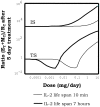Mathematical Models of the Impact of IL2 Modulation Therapies on T Cell Dynamics
- PMID: 24376444
- PMCID: PMC3858650
- DOI: 10.3389/fimmu.2013.00439
Mathematical Models of the Impact of IL2 Modulation Therapies on T Cell Dynamics
Abstract
Several reports in the literature have drawn a complex picture of the effect of treatments aiming to modulate IL2 activity in vivo. They seem to promote either immunity or tolerance, probably depending on the specific context, dose, and timing of their application. Such complexity might derive from the pleiotropic role of IL2 in T cell dynamics. To theoretically address the latter possibility, our group has developed several mathematical models for Helper, Regulatory, and Memory T cell population dynamics, which account for most well-known facts concerning their relationship with IL2. We have simulated the effect of several types of therapies, including the injection of: IL2; antibodies anti-IL2; IL2/anti-IL2 immune-complexes; and mutant variants of IL2. We studied the qualitative and quantitative conditions of dose and timing for these treatments which allow them to potentiate either immunity or tolerance. Our results provide reasonable explanations for the existent pre-clinical and clinical data, predict some novel treatments, and further provide interesting practical guidelines to optimize the future application of these types of treatments.
Keywords: T cell dynamics; interleukin 2; interleukin 2 mutants; mathematical model; regulatory T cells.
Figures










Similar articles
-
Modeling the role of IL2 in the interplay between CD4+ helper and regulatory T cells: studying the impact of IL2 modulation therapies.Int Immunol. 2012 Jul;24(7):427-46. doi: 10.1093/intimm/dxr120. Epub 2012 Feb 27. Int Immunol. 2012. PMID: 22371423
-
IL2/Anti-IL2 Complex Combined with CTLA-4, But Not PD-1, Blockade Rescues Antitumor NK Cell Function by Regulatory T-cell Modulation.Cancer Immunol Res. 2019 Mar;7(3):443-457. doi: 10.1158/2326-6066.CIR-18-0697. Epub 2019 Jan 16. Cancer Immunol Res. 2019. PMID: 30651291
-
Modeling the role of IL-2 in the interplay between CD4+ helper and regulatory T cells: assessing general dynamical properties.J Theor Biol. 2010 Feb 21;262(4):720-32. doi: 10.1016/j.jtbi.2009.10.025. Epub 2009 Oct 28. J Theor Biol. 2010. PMID: 19878686
-
Combining computational and experimental biology to develop therapeutically valuable IL2 muteins.Semin Oncol. 2018 Jan;45(1-2):95-104. doi: 10.1053/j.seminoncol.2018.04.001. Epub 2018 May 1. Semin Oncol. 2018. PMID: 30318089 Review.
-
An IL-2 proaerolysin fusion toxin that selectively eliminates regulatory t cells to enhance antitumor immune response.Prostate. 2019 Jul;79(10):1071-1078. doi: 10.1002/pros.23819. Epub 2019 May 6. Prostate. 2019. PMID: 31059598 Review.
Cited by
-
Modeling the T cell immune response: a fascinating challenge.J Pharmacokinet Pharmacodyn. 2014 Oct;41(5):401-13. doi: 10.1007/s10928-014-9376-y. Epub 2014 Aug 26. J Pharmacokinet Pharmacodyn. 2014. PMID: 25155903 Free PMC article. Review.
-
CARTmath-A Mathematical Model of CAR-T Immunotherapy in Preclinical Studies of Hematological Cancers.Cancers (Basel). 2021 Jun 11;13(12):2941. doi: 10.3390/cancers13122941. Cancers (Basel). 2021. PMID: 34208323 Free PMC article.
-
Modeling the receptor pharmacology, pharmacokinetics, and pharmacodynamics of NKTR-214, a kinetically-controlled interleukin-2 (IL2) receptor agonist for cancer immunotherapy.PLoS One. 2017 Jul 5;12(7):e0179431. doi: 10.1371/journal.pone.0179431. eCollection 2017. PLoS One. 2017. PMID: 28678791 Free PMC article.
-
Modeling cell-specific dynamics and regulation of the common gamma chain cytokines.Cell Rep. 2021 Apr 27;35(4):109044. doi: 10.1016/j.celrep.2021.109044. Cell Rep. 2021. PMID: 33910015 Free PMC article.
-
Systems approach to the study of brain damage in the very preterm newborn.Front Syst Neurosci. 2015 Apr 14;9:58. doi: 10.3389/fnsys.2015.00058. eCollection 2015. Front Syst Neurosci. 2015. PMID: 25926780 Free PMC article.
References
-
- Fishman M, Hunter TB, Soliman H, Thompson P, Dunn M, Smilee R, et al. Phase II trial of B7-1 (CD-86) transduced, cultured autologous tumor cell vaccine plus subcutaneous interleukin-2 for treatment of stage IV renal cell carcinoma. J Immunother (2008) 31(1):72–8010.1097/CJI.0b013e31815ba792 - DOI - PubMed
-
- Tarpey I, van Loon AA, de Haas N, Davis PJ, Orbell S, Cavanagh D, et al. A recombinant turkey Herpesvirus expressing chicken interleukin-2 increases the protection provided by in ovo vaccination with infectious bursal disease and infectious bronchitis virus. Vaccine (2007) 25(51):8529–3510.1016/j.vaccine.2007.10.006 - DOI - PubMed
Publication types
LinkOut - more resources
Full Text Sources
Other Literature Sources

